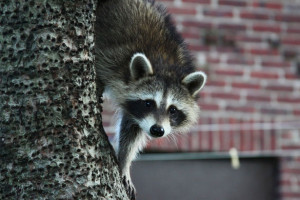 Last week, a sick raccoon in Hamilton, Ontario got into an altercation with two bull mastiffs in the back of an animal services van. The story quickly hit the media (and social media). Because the raccoon was not acting normally (and was actually reportedly very aggressive), it was euthanized. Because it also had direct contact with the two dogs (which both sustained wounds that broke the skin and could have come in contact with the raccoon’s saliva), the raccoon was tested for rabies. And it was positive.
Last week, a sick raccoon in Hamilton, Ontario got into an altercation with two bull mastiffs in the back of an animal services van. The story quickly hit the media (and social media). Because the raccoon was not acting normally (and was actually reportedly very aggressive), it was euthanized. Because it also had direct contact with the two dogs (which both sustained wounds that broke the skin and could have come in contact with the raccoon’s saliva), the raccoon was tested for rabies. And it was positive.
Not only is this the first case of terrestrial (i.e. not bat) rabies in all of Southern Ontario since 2012, it is the first case of terrestrial rabies in the Hamilton area since 1994. The really interesting (though perhaps not altogether surprising) part is that when they typed the rabies virus it turned out to be raccoon-variant, making this the first time this strain has ever been detected in Southwestern Ontario. The previous outbreak of raccoon-variant rabies in Ontario occurred from 1999-2005, but through the efforts of the Ministry of Natural Resources and Forestry (MNRF) it was contained to a 50 km radius in the Brockville-Prescott area. The MNRF continues to drop oral rabies vaccine baits for wildlife along the US border in Niagara and along the St. Lawrence on an annual basis, to try to keep a “buffer” of vaccinated wildlife in case an infected animal crosses over from New York State (where terrestrial rabies is much more common). Finding a positive raccoon-variant case in Hamilton is a significant breach of this protective zone. However, it is unknown if the virus reached the Hamilton area through natural transmission or if the raccoon may have been inadvertently transported to the area by other means (e.g. a stow-away on a vehicle from across the border).
The Ontario Ministry of Agriculture, Food and Rural Affairs (OMAFRA), which helps private veterinarians handle domestic animal exposure cases since the Canadian Food Inspection Agency (CFIA) ended their rabies response activities in April 2014, has released a Veterinary Alert (also available in French) about the case. It is particularly important for veterinarians in the Hamilton and Niagara areas to remain vigilant for cases of domestic animal exposure to potentially rabid animals, in order to help prevent any further spread of the raccoon-variant rabies virus, and of course to protect people who take care of the exposed animals.
The two most important steps for protecting people and animals are:
- Avoid contact with wildlife (especially abnormally-acting wildlife)
- Keep pets up-to-date on their rabies vaccinations
Lots more information on rabies and rabies response in Ontario, for owners and veterinarians, can be found on the recently updates OMAFRA Rabies website.